It’s that special time of your high school career. You’re a high school junior or senior and you’re about to take the SAT.
You’ve heard all about it. Perhaps you’ve even taken the PSAT so you’re well aware that there is a LOT of math to know for the exam! In this article, we’ll break the SAT math into manageable topics to help you feel confident on SAT Day!
Let’s get started!
A few notes on the background of the test – the math questions are divided into 4 categories: Heart of Algebra, Passport to Advanced Mathematics, Problem Solving/Data Analysis, and Additional Topics in Math.
Let’s take a closer look:
| Category | Some Types of Questions | Number of questions |
|---|---|---|
| Heart of Algebra | -linear equations -systems of equations | 19 |
| Passport to Advanced Math | -more complex equations -quadratic functions -exponential functions -radicals -rational exponents | 16 |
| Problem Solving/ Data Analysis | -ratios -percentages -probability -statistics -scatterplots -lines of best fit -interpreting charts and graphs | 17 |
| Additional Topics in Math | geometry, trigonometry, complex numbers | 6 |
Notice from the table that algebra is the most important topic on the exam. The Heart of Algebra covers linear equations and systems but there are also plenty of algebra problems in the Passport to Advanced Mathematics category and the Problem Solving/Data Analysis category.
So, no matter how you feel about algebra, you won’t be able to get away from it on the SAT!
Let’s look at the 8 important math topics to know for the SAT:
- Lines
- Quadratic Functions/Parabolas
- Factoring
- Exponential Functions
- Systems of Equations
- Trigonometry
- Geometry
- Data Interpretation
Now, we’ll go into detail for each topic.
Lines
In Algebra 1, one of the most important topics is linear functions. In other words: working with straight lines.
There are a few important concepts to remember about lines. First, the slope of a line measures its steepness. The slope is usually represented by m.
Recall:
The slope of line between two points (x1, y1) and (x2, y2):
m = rise/run
OR
m = (y2 – y2) / (x2– x1)
Example
Find the slope of the line below.
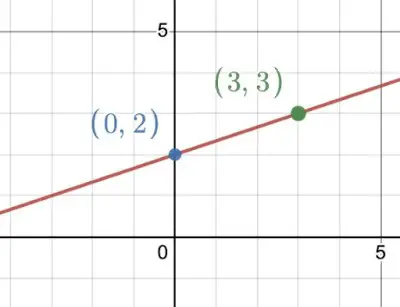
Solution
We can easily calculate the slope using the points that are labeled. Starting with the point (3, 3), we’ll find the difference of the y-coordinates, then we’ll divide by the difference of the x-coordinates.
- Slope = (3 – 2) / (3 – 0)
- = 1/3
So, the slope is 1/3. The main thing to remember when calculating slope is consistency. When calculating the rise over the run, whichever point you start with for the numerator, you have to start with that same point for the denominator.
An important form of the equation of a line is Slope-Intercept Form.
| Slope-intercept Form of a line: y=mx+b where m = slope and b= y-intercept. |
Example
Write the equation of a line with a slope of 1/2 that passes through the point (6, -10).
Solution
To solve this problem, we need to find the slope m and the y-intercept b. The slope is given to us in the problem so m = 1/2. To find b, we can use the point (6, -10) and plug in values for x and y.
- y = mx + b
- -10 = (1/2)*(6) + b
- -10 = 3 + b
- -13 = b
- b = -13
So, our equation is y = (1/2)x – 13
Another important form of a line that comes up on the SAT is Standard Form. When this form is used, it’s easy to find the slope using the formula -A/B, as shown.
Often, students solve for y to find the slope but this can be time consuming so it’s good to remember the formula below.
| Standard Form of a line: Ax+By=C (slope = -A/B ) Note: A is the coefficient of x and B is the coefficient of y. |
Example
Find the slope of the line -2x + 5y = 10
Solution
Since the equation is in standard form, we have that A is -2 and B is 5. Using the formula -A/B, we obtain:
- Slope =-(-2)/5
- m = 2/5
Hence, the slope is m = 2/5.
There are two situations where we have special slopes: parallel lines and perpendicular lines. It’s worth remembering these special cases!
| Slopes Parallel Lines have the same slope. Perpendicular Lines have slopes that are negative (or opposite) reciprocals. That is, the slopes multiply to -1. For example, two lines with slopes 3 and -⅓ are perpendicular. |
Now, let’s move to quadratic functions.
Quadratic Functions/Parabolas
On the SAT, quadratic functions come up quite a bit. You may remember them.
The graph of a quadratic function is a parabola – a U shape that opens up or down. There are three forms of a quadratic function.
It’s important that you’re comfortable working with all of the forms listed here.
Standard Form: y=ax2+bx+c
if a>0 then the parabola opens up
if a<0 then the parabola opens down
(0, c) is the y-intercept
-b/2a is the formula for the x-coordinate of the vertex
Vertex Form: y= a(x-h)2+k where (h,k) is the vertex
if a>0 then the parabola opens up
if a<0 then the parabola opens down
Intercept Form: y=a(x – p)(x – q)
(Factored Form)
if a>0 then the parabola opens up
if a<0 then the parabola opens down
(p,0) and (q, 0) are the x-intercepts
To find the x- coordinate of the vertex, find the midpoint of the x-intercepts.
Each form of a quadratic function has its advantages. Standard form is great for finding the y-intercept and it’s easy to find the x-coordinate of the vertex using the formula -b/2a.
Vertex form is helpful if you’re trying to find, you guessed it, the vertex! And, intercept form is great for finding the x-intercepts.
When working with quadratic functions it’s often required that we have to factor. Factoring is our next topic.
Factoring
Factoring is an important skill to know for the SAT. Several questions on the SAT will likely involve factoring so here are some tips.
| Factor out the GCF, the Greatest Common Factor. |
Example
Solve by factoring: 7x2 – 21x = 0
Solution
Notice that there are only two terms in this equation. The greatest common factor of 7x2 and -21x is 7x. Factoring that out, we get:
- 7x(x – 3) = 0
Now, we can set each factor to 0 and solve:
| 7x = 0 –> x = 0 | x – 3 = 0 -> x = 3 |
So, the solutions are x = 0 and x = 3.
Another common factoring problem will involve factoring a trinomial. In this case, we can use the idea of Reverse FOIL.
| Reverse FOIL x2+(a + b)x + ab = (x + a)(x + b) |
Example
Solve by factoring: x2 – 10x + 16 = 0
Solution
To solve a quadratic equation that has a leading coefficient of 1, we can use the sum and product rules that we get from Reverse FOIL. We know that x2 factors to x ᐧ x, so we can start the process by putting the x’s in their appropriate places.
(x )(x )
Now, we want two numbers that will multiply to 16 that will add/subtract to -10. Factors of 16 are:
- 16 ᐧ 1
- 8 ᐧ 2
- 4 ᐧ 4
Since the two numbers have to multiply to positive 16 and add to negative 10, we know that both of the factors will be negative. To combine to -10, we can use the factors 8 and 2. So we get:
- (x – 8)(x – 2) = 0
Now, we can easily solve this by setting each factor to 0. So, our solutions are x = 8 and x = 2.
The SAT seems to really like the special case of factoring called the Difference of Squares.
| Difference of Squares x2 – y2 =(x – y)(x + y) |
Example
Solve: 9x2 – 16 = 0
Solution
Using the difference of squares, we can easily factor:
- 9x2 – 16 = 0
- (3x – 4)(3x + 4) = 0
Set each factor to 0 and solve:
| 3x- 4 = 0 3x = 4 x = 4/3 | 3x + 4 = 0 3x = -4 x = -4/3 |
Hence, the solutions are x = 4/3 and x = -4/3.
Moving on from polynomials, let’s look at some exponential functions.
Exponential Functions
| An exponential function with base b is defined by f (x) = abx where a ≠0, b > 0, b ≠1, and x is any real number. |
Note: The exponent x is the variable. The base b is a constant. The domain for the function is the real numbers and the range is the positive real numbers.
A simple example of an exponential function is y = 2x. Don’t get this function confused with the quadratic function y = x2.
With exponential functions, the base is a number and the exponent is a variable. This is important to remember.
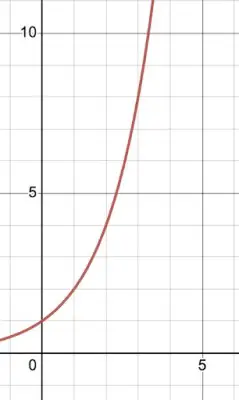
The SAT really seems to like exponential growth and decay questions. Let’s take a look:
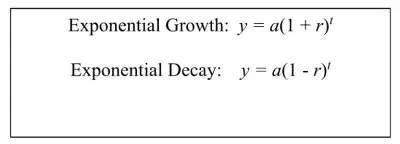
- a = initial value (the amount before measuring growth or decay)
- r = growth or decay rate (most often represented as a percentage and expressed as a decimal)
- t = number of time intervals that have passed
Example
A researcher estimates that the population of a town is increasing at an annual rate of 1.2%. If the current population of the town is 14,230, which of the following expressions appropriately models the population of the town t years from now according to the researcher’s estimate?
A) 14,230(1 + 0.012) t
B) 14,230(1 + 0.12) t
C) 14,230 + 1.012t
D) 14,230(0.012)t
Solution
First, eliminate obvious incorrect answers. We know this is a problem involving exponential growth, so we can eliminate choice (C) since it’s a linear function.
To correctly calculate the growth rate, let’s convert the percent to a decimal. To convert 1.2% to a decimal, simply move the decimal two places to the left. We obtain the decimal 0.012. This eliminates choice (B).
We know from our growth formula, that we need to have 1 plus the growth rate so that our base will be a number greater than 1. So, our answer must be choice (A).
Systems of Equations
On a typical SAT exam, you’ll encounter a few problems involving systems of linear equations. Sometimes there will be a system of equations that may involve a quadratic function as well, but most will be of the linear variety.
Here is a typical example of an SAT systems problem:
Example
5x + 4y = 2
3x – 2y =10
For the above system of equations, what is the x-coordinate of the solution (x, y)?
- -3
- 0
- 2
- 11
Solution
This system of equations is lined up nicely; that is, both equations are in standard form. The x terms line up, the y terms line up, and the constants line up.
In this case, using the elimination method will be the best way to solve this system. The goal is to eliminate one of the variables by adding the two equations.
In order for the variable to cancel out, the coefficients of the variable must have opposite values. In our example, we can multiply the second equation by 2. This will allow us to easily cancel out the y terms.
5x + 4y = 2
2(3x – 2y =10)
Now we have:
5x + 4y = 2
6x – 4y =20
Adding the two equations, we obtain:
11x = 22
Divide both sides by 11 and we get:
x = 2
Now, we can plug x= 2 back into either equation to solve for y.
Using the first equation, we get:
- 5x + 4y = 2
- 5(2) + 4y = 2
- 10 + 4y = 2
- 4y = -8
- y = -2
The solution to the system is (2, -2).
Sometimes, there is a shortcut to solving a system on the SAT. They don’t always ask for the solution of the system.
Example
If 4x – y = 10 and x + 5y = 12, what is the value of 3x – 6y?
- -2
- -1
- 0
- 3
Solution
First, line up the two equations:
4x – y = 10
x + 5y = 12
Notice, the SAT question asks to find 3x – 6y. If we try to solve this using the elimination method, we’ll have to solve for x and y, then plug in the values to the expression 3x – 6y. This can be time consuming.
Often, it’s helpful to first try adding or subtracting the given equations. In this case, if we add the equations we obtain:
5x + 4y = 22
That didn’t help too much. But, what if we subtract the equations? Now we obtain:
3x -6y = -2
We got the exact expression we’re looking for on the left side! So, the answer is -2. Choice (A) is correct.
Trigonometry
There will be a few questions on the SAT involving trigonometry. Most of the problems will involve right triangle trigonometry. In some cases, there may be a problem that involves a unit circle trigonometry. In this article, we’ll look at right triangle trigonometry.
Recall:

In trigonometry, it’s important to be aware that the opposite leg and the adjacent leg will depend on which angle you’re working with. In the above triangle, relative to angle A, the opposite leg is a. Relative to angle B, the opposite leg is b.
Example
Triangle ABC (not shown) has right angle B. If sin A = 5/13, what is tan C?
Solution
To solve this problem, we need to draw a diagram. Be careful to label the right angle B because if we mislabel it, our answer will be wrong.

Since we’re given that sin A = 5/13 and the sine ratio is opposite/hypotenuse, we can label the triangle as such:
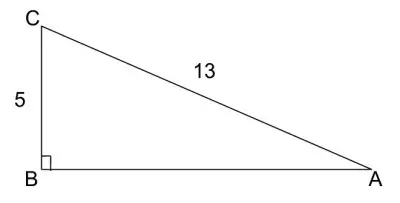
From Geometry, we know that a common right triangle has sides of lengths 5-12-13. So, we can label the other leg 12.
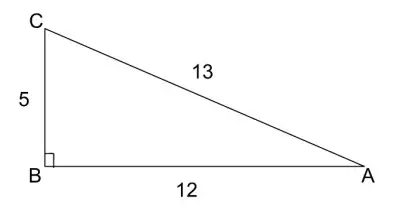
We’re looking for tan C which is the ratio opposite leg / adjacent leg. Relative to angle C, the opposite leg is 12 and the adjacent leg is 5 so the ratio is 5/12.
Another Trigonometry fact that the SAT seems to like, meaning there is usually one question on every SAT exam that involves this concept is the Sine/Cosine Complementary Angle relationship.
| The sine of an acute angle is equal to the cosine of the angle’s complement, sin x = cos (90-x) OR The cosine of an acute angle is equal to the sine of the angle’s complement, cos x = sin (90-x) |
Geometry
Geometry topics on the SAT typically involve triangles, circles, areas, and volumes. Conveniently, the SAT gives you most of the geometry formulas you’ll need to know for the exam. They are listed at the beginning of each section.
Example
The area of a circle is 16. Find the circumference.
Solution
The formula for the area of a circle is A = πr2 and the formula for the circumference is C= 2πr. We’re given that the area of the circle is 16π.
We’ll solve this problem by finding the radius then plugging that value into the circumference equation. Set the area formula equal to 16 and solve for r.
- πr2 = 16π
- r2 = 16
- r = 4
Now we can plug the radius r = 4 into the circumference formula.
- C = 2πr
- C = 2π(4)
- C = 8π
Hence, the circumference of the circle is 8π.
Example
What is the volume, in cubic centimeters, of a right rectangular prism that has a length of 8 centimeters, a width of 5 centimeters, and a height of 12 centimeters?
Solution
A right rectangular prism is a rectangular solid, or, in simpler terms, it’s a fancy way of saying “a box.” Conveniently, if we don’t already know the formula for the volume of a rectangular solid, the SAT gives it to us. The volume is equal to the length times the width times the height:
- V = lwh
- V = 8ᐧ 5ᐧ 12
- V = 480
Therefore, the volume of the right rectangular prism is equal to 480 cubic centimeters.
Data Interpretation
Often on the SAT, there are problems in which we have to interpret data from a table, graph, or chart. Let’s look at a few examples.
Example
| Selected to be on Quiz Show | Not Selected to be on Quiz Show | |
| Took One Day Seminar | 7 | 34 |
| Did Not Take One Day Seminar | 4 | 105 |
The table above summarizes the results of 150 people who tried out to be contestants on a popular TV quiz show. Some of the people surveyed took a one day seminar to help people maximize their chances of being selected for game shows.
If one of the surveyed people who was selected to be on the show is chosen at random to participate in the next day’s show, what is the probability that the person selected did NOT participate in the one day seminar?
A) 450
B) 4139
C) 411
D) 711
Solution
This example uses conditional probability. We are given that one of the surveyed persons who was selected to be on the quiz show is chosen at random and we want to determine the probability that the person selected did NOT participate in the one day seminar.
Since we know the person was selected to be on the quiz show, we only want to work with numbers from the column “Selected to be on Quiz Show.” We’ll need the total from that column: 7 + 4 = 11.
For the numerator, we want the number of people who did NOT take the seminar, which is 4. So the probability is 4/11, Choice (C) is the correct answer.
Example
In Sunnytown in July of 2022, daily high temperatures in ℉ are recorded in the table below.
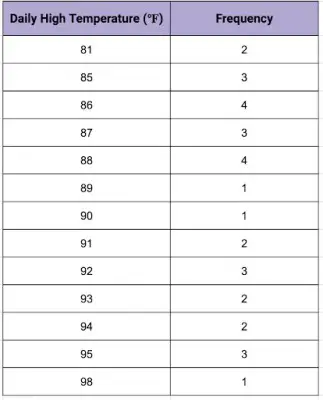
Find the median daily high temperature in Sunnytown for July of 2022.
Solution
Recall that the median of a list of numbers is the middle number, when the list is in either increasing or decreasing order. If there are two middle numbers, the median is the mean of the two middle numbers.
We can see from the chart that the temperatures are already in ascending order. To determine the median, we need to be sure that we take the frequency of the temperatures into account.
A common mistake students make is simply finding the median of the first column of temperatures. But, in this case, we have 31 numbers, since there are 31 days in July.
The middle number occurs at item 16. So, we can use the frequency column to count when we have reached the 16th number.
Starting from the top of the frequency column, we can see that this will occur with the row for 88℉. Hence, the median daily high temperature for Sunnytown in July was 88℉! Kind of a hot month!
As you prepare for the SAT, it’s important to study these topics. A great way to study is to keep working on practice tests.
The College Board has 8 free practice tests that are available online. They provide answer explanations and scoring guidelines to assess how you’re doing. So, start studying!
You can learn more about what to know for the SAT Math section here.
You can learn all about the new Digital SAT here.
Applying to colleges? Learn about early decision, early action, and regular decision here.
You can learn about the factors to consider when choosing a college here.
I hope you found this article helpful. If so, please share it with someone who can use the information.
Don’t forget to subscribe to our YouTube channel & get updates on new math videos!
About the author:
Jean-Marie Gard is an independent math teacher and tutor based in Massachusetts. You can get in touch with Jean-Marie at https://testpreptoday.com/.



